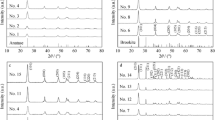Abstract
The effect of synthesis conditions on morphology and catalytic activity has been studied for hydrothermal preparation of TiO2 from acidified aqueous TiOSO4 solution. It was found that the increase in TiOSO4 and H2SO4 concentration results in the increase of photocatalytic activity of produced TiO2, as it was revealed by steady-state gas-phase oxidation of acetone and ethanol vapors in a flow-circulating reactor. TiOSO4 concentration exerts strong influence on the shape of the produced TiO2 particles. At TiOSO4 concentration less than 0.1 wt%, hydrolysis gives rise to hedgehog-like agglomerates consisting of spliced-blade TiO2 nanocrystals. At higher concentration of TiOSO4, the resultant TiO2 consists of round agglomerates of 5–10 nm primary particles. The size of secondary particles depends mainly on the H2SO4 concentration. The increase of the time of hydrothermal treatment results in the enhancement of TiO2 photocatalytic activity that reaches a maximum. Among different acids (HCl, HClO4, HNO3, H3PO4 and CH3COOH) added during hydrolysis of TiOSO4, sulfuric and acetic acids had the best effect on photocatalytic activity of TiO2. The results obtained can help to finely tune this TiO2 preparation method in order to obtain desirable particles size, shape and activity.
Similar content being viewed by others
References
A. Fujishima, K. Hashimoto and T. Watanabe, TiO 2 Photocatalysis, BCK, Tokyo (1999).
T. Ohno, K. Sarukawa and M. Matsumura, J. Phys. Chem. B 105, 2417 (2001).
A. J. Maira, K. L. Yeung, C. Y. Lee, P. L. Yue and C. K. Chan, J. Catal, 192, 185 (2000).
G. Goutailler, C. Guillard, S. Daniele and L. G. Hubert-Pfalzgraf, J. Mater. Chem. 13, 342 (2003).
Q. H. Zhang, L. Gao and J. K. Guo, Appl. Catal. B: Environ. 26, 207 (2000).
S. E. Pratsinis and P. T. Spicer, Chem. Eng. Sci. 53, 1861 (1998).
T. C. Lu, P. Song, L. B. Lin, Y. Lu, X. T. Zu and Z. J. Liao, J. Inorg. Mater. 16, 475 (2001).
U. Gesenhues, Chem. Eng. Technol. 24, 685 (2001).
A. Tsevis, N. Spanos, P. G. Koutsoukos, A. J. Linde and J. Lyklema, J. Chem. Soc. Faraday Trans. 94, 295 (1998).
Y. V. Kolen’ko, A. A. Burukhin, B. R. Churagulov and N. N. Oleynikov, Mater. Lett. 57, 1124 (2003).
S. Ito, S. Inoue, H. Kawada, M. Hara, M. Iwasaki and H. Tada, J. Coll. Interface Sci. 216, 59 (1999).
M. Inagaki, Y. Nakazawa, M. Hirano, Y. Kobayashi and M. Toyoda, Int. J. Inorg. Mater. 3, 809 (2001).
M. Iwasaki, M. Hara, H. Kawada, H. Tada and S. Ito, J. Colloid Interface Sci. 224, 202 (2000).
D. V. Bavykin, E. N. Savinov and P. G. Smirniotis, React. Kinet. Catal. Lett. 79, 77 (2003).
S. Karvinen and R.-J. Lamminmaki, Solid State Sci. 5, 1159 (2003).
F. Kh. Urakaev, L. Sh. Bazarov, I. N. Meshcheryakov, V. V. Feklistov, T. N. Drebushchak, Yu. P. Savintsev, V. I. Gordeeva and V. S. Shevchenko, J. Cryst. Growth 205, 223 (1999).
M. Hirano, C. Nakahara, K. Ota, O. Tanaike and M. Inagaki, J. Solid State Chem. 170, 39 (2003).
A. V. Vorontsov, A. A. Altynnikov, E. N. Savinov and E. N. Kurkin, J. Photochem. Photobiol. A: Chem. 144, 193 (2001).
D. Kozlov, D. Bavykin and E. Savinov, Catal. Lett. 86, 169 (2003).
A. V. Vorontsov, E. N. Savinov, G. B. Barannik, V. N. Troitsky and V. N. Parmon, Catal. Today 39, 207 (1997).
A. V. Vorontsov, E. N. Savinov and Z. Jin, J. Photochem. Photobiol. A: Chem. 125, 113 (1999).
M. Ahmed, H. Fjellvag and A. Kjekshus, Acta Chim. Scand., 50, 275 (1996).
F. A. Cotton and G. Wilkinson, Advanced Inorganic Chemistry, Interscience, New York, NY (1969).
P. Comba and A. Merbach, Inorg. Chem. 26, 1315 (1987).
L. G. Gerasimova, R. F. Ohrimenko and N. M. Zhdanova, Lakokras. Mater. Ikh Primen. 10, 13 (1998) (in Russian).
A. V. Vorontsov and V. P. Dubovitskaya, J. Catal. 221, 102 (2004).
K. Yanagisawa and J. Ovenstone, J. Phys. Chem. B. 103, 7781 (1999).
M. Abdullah, G. K. C. Low and R. W. Matthews, J. Phys. Chem. 94, 6820 (1990).
Author information
Authors and Affiliations
Corresponding author
Rights and permissions
About this article
Cite this article
Bavykin, D.V., Dubovitskaya, V.P., Vorontsov, A.V. et al. Effect of TiOSO4 hydrothermal hydrolysis conditions on TiO2 morphology and gas-phase oxidative activity. Res. Chem. Intermed. 33, 449–464 (2007). https://doi.org/10.1163/156856707779238702
Received:
Accepted:
Issue Date:
DOI: https://doi.org/10.1163/156856707779238702




